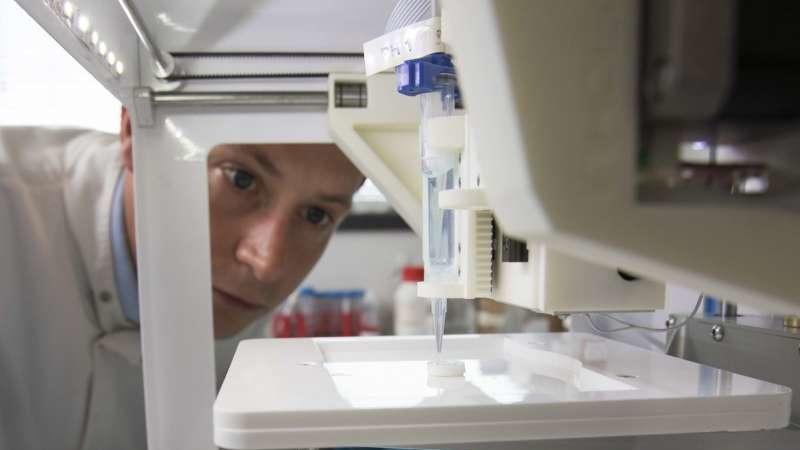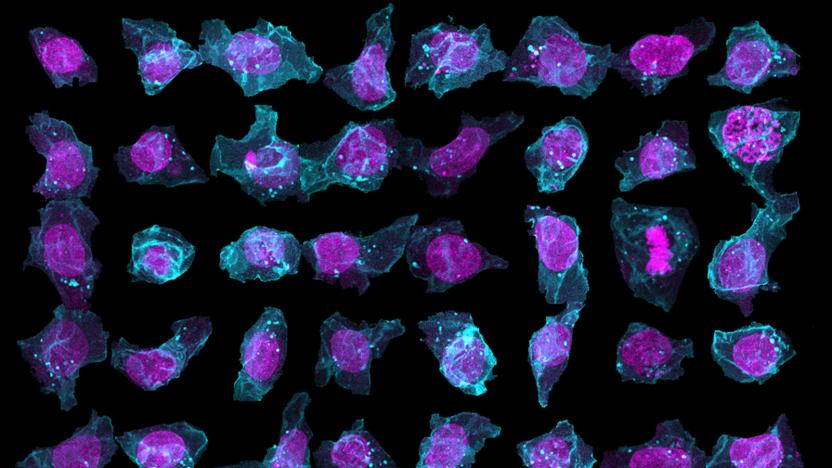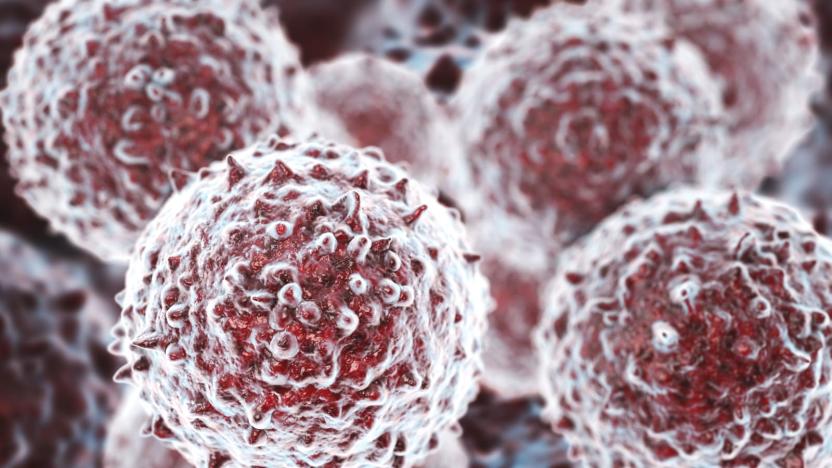stemcell
Latest

Stem cell transplant offers hope for an HIV cure
There appears to be more than one promising sign in the quest for an HIV cure. Researchers have given a London patient a bone marrow stem cell transplant that has left him HIV-free for the past 18 months. As the donor has a very rare genetic mutation (CCR5 delta 32) that makes them HIV-resistant, the stem cells sent the HIV into remission with only a "mild reaction" from the treatment. It's a positive sign, and it suggests that the stem cell transplants that 'cured' Tim Brown in 2007 weren't just flukes.

Skeletal stem cells could regrow damaged bones
Believe it or not, scientists are still discovering new forms of stem cells -- and these latest examples could shake up how doctors treat a multitude of common injuries. A Stanford-led research team has identified the human skeletal stem cell, helping the group create a "family tree" of cells that can regenerate bones and cartilage. You can either isolate them from existing bones or generate them from specialized cells in fat, and they're predictable enough (that is, they'll always make bone tissue) that doctors wouldn't have to worry much about unintended results when using them in treatments.

Scientists create the first 3D-printed human corneas
Newcastle University researchers have devised a groundbreaking experimental technique that could help millions on the corneal transplant waiting list. By using a simple 3D bio-printer, Professor of Tissue Engineering Che Connon and his team of scientists were able to combine healthy corneal stem cells with collagen and alginate (a type of sugar sometimes used in tissue regeneration) to create 'bio-ink' -- a printable solution that enabled them to reproduce the shape of a human cornea in just 10 minutes.

3D gel stacks can grow enough stem cells to treat brain disease
Programmed stem cells promise to tackle all kinds of illnesses, but there's one catch: making them. It's hard to cultivate large numbers of them, and the need to grow them on 2D surfaces isn't very practical. That's where researchers might come to the rescue: they've developed a method of growing neural stem cells in large volumes, but without chewing up too much valuable real estate. The trick is to use polymer-based gels that allow these juvenile cells to grow in 3D stacks.

Lab-grown stem cells may carry an increased risk of cancer
If you've followed the latest medical research, you know that stem cells are a big deal. They let you repurpose cells so that you can theoretically grow them into whatever you need. However, scientists just got a good reason to be more cautious than they have in the past. A Harvard team has discovered that five of the 140 human embryonic stem cell lines registered for research use in US labs have cells whose mutations can cause cancer. Two of the lines have been used in human trials, too. None of those patients has developed cancer, thankfully, but there's a "very real risk" it could happen.

Gene editing could lead to a vaccine for arthritis
Right now, arthritis treatment tends to be an all-or-nothing proposition: the drugs you take affect your entire body, causing havoc with your immune system and leaving you prone to infections. But how do you narrow the treatment to just those areas where you feel pain? Genetics, apparently. Researchers have used CRISPR gene editing to turn stem cells into cartilage that releases a biological anti-inflammatory drug when they encounter inflammation. It not only limits treatment to the affected area, but responds only when there's a pain flare. You only get relief when you need it.

AI predicts the layout of human stem cells
The structures of stem cells can vary wildly, even if they're genetically identical -- and that could be critical to predicting the onset of diseases like cancer. But how do you know what a stem cell will look like until it's already formed? That's where the Allen Institute wants to help: it's launching an online database, the Allen Cell Explorer, where deep learning AI predicts the layout of human stem cells. You only need a pair of identifying structures, like the position of the nucleus, to fill out the rest of the cell's innards.

Man receives someone else's reprogrammed stem cells
The concept of using stem cells for transplants just became a truly practical reality: a Japanese man with age-related macular degeneration has received the first transplant of stem cells from another human donor. Doctors repurposed the donor's skin cells by turning them into induced pluripotent stem cells (that is, forced into a state where they can become many kinds of cells) that then became retinal cells. If all goes according to plan with the multi-step procedure, these fresh cells will halt the degeneration and preserve the patient's remaining eyesight.

Scientists create fully-functional brain neurons from mouse skin cells
It's a good excuse to shoehorn Pinky and the Brain on to the site, but scientists have managed to graft neurons reprogrammed from skin cells into the brains of mice. It isn't the first time that's been done, but it is the first time the researchers have had any luck with the neurons surviving into long-term stability. Better still, six months after implantation, the neurons had become fully-functional inside the brain. Cell replacement therapy would be able to treat neurodegenerative diseases like Parkinson's, replacing non-working neurons with new cells reprogrammed from elsewhere. It's still a ways off, however, according to stem cell research head Prof. Schwamborn: "I am sure successful cell replacement therapies will exist in future. Our research results have taken us a step further in this direction."

Weekends with Engadget: Tokyo's vending machines, new buyer's guides and more!
This week, we learned about the dangers of stem cell treatment, explored the world of 3D motion capture and went on a vending machine shopping spree in Tokyo. Read on for Engadget's news highlights from the last seven days. Oh, and be sure to subscribe to our Flipboard magazine!

Scientists get much closer to cloning human embryos from adult stem cells
It's relatively easy to clone embryos from the adult stem cells of simpler animals like sheep, but humans have proved challenging. Even an attempt last year only used baby cells. The process just took a gigantic step forward, though, as scientists have finally used an adult human's stem cells to clone a pre-embryonic blastocyst. The process was mostly similar to that for other species: researchers removed the DNA from the nucleus of an unfertilized egg and inserted a skin cell into that egg. From there, the team only needed growth chemicals to develop the stem cells into specific cell types, such as heart tissue.

Researchers create 'programmable' stem cells through stress
Making stem cells in the lab is typically a complicated process, and there isn't much variety in the results without resorting to foreign DNA. However, researchers at both Brigham and Women's Hospital and Japan's RIKEN may have found a way to easily create most any stem cell a doctor would need. Their new technique subjects adult cells to extreme stress, such as oxygen deprivation. The victims that survive the process retreat into a state much like that of an embryonic stem cell; after that, scientists just have to grow the cells in the right environment to get the stem cells they want. It will be a while before the team tests this process with humans, but it could lead to stem cells tailor-made for specific patients -- you'd only have to provide a blood sample to get replacement tissues.

Regenerative medicine pioneer continues changing lives with first successful laryngotracheal implants
Dr. Paolo Macchiarini is no stranger to world firsts, and less than a year after performing a synthetic windpipe transplant, the Karolinska Institute Professor has coordinated no less than two successful transplants of synthetic sections of larynx. Amazingly, both patients were able to breathe and talk normally straight after surgery, the basic functions we take for granted that they either struggled with or were simply unable to do before. The implants consisted of personally designed synthetic scaffolds coated with the candidates' own stem cells, so there's neither the chance of rejection nor the burden of life-long immunosuppressant therapy. Despite the amazing feat, Dr. Macchiarini ain't done yet, claiming this is the first of many steps towards building a synthetic, complete larynx -- voice box and all. Jump past the break for the official PR issued by Harvard Bioscience, the company responsible for growing what's in that tub.

ZiiLabs demos Ice Cream Sandwich on its Jaguar 7 tablet, looks swift and tasty (video)
It's been few months since ZiiLabs introduced more hardware designs for its Jaguar line of OEM-oriented reference tablets, and now, the company has released a brief demo video of its seven-inch variant tasting Android Ice Cream Sandwich. Up until this point, we'd only seen the devices rocking Honeycomb atop Zii's ZMS-20 dual-core processor, but it appears to handle Google's latest frozen treat -- specifically Android OS version 4.0.1 -- with relative ease. The clip highlights quick transitions through a few menu interfaces, followed by a showcase of the slate's OpenGL graphics and StemCell media acceleration with decidedly smooth looking multitouch interactions. Curious to see for yourself? You'll find the whole 57 seconds of video goodness just past the break. [Thanks, Tim]

Researchers create spinal cord connectors from human stem cells, heralding breakthrough
It's taken many years and more than a bit of brainpower, but researchers at the University of Central Florida have finally found a way to create neuromuscular connectors between muscle and spinal cord cells, using only stem cells. Led by bioengineer James Hickman, the team pulled off the feat with help from Brown University Professor Emeritus Herman Vandenburgh, who collected muscle stem cell samples from adult volunteers. After close examination, they then discovered that under the right conditions, these samples could be combined with spinal cord cells to form connectors, or neuromuscular junctions, which the brain uses to control the body's muscles. UCF's engineers say the technique, described in the December issue of the journal Biomaterials, marks a major breakthrough for the development of "human-on-a-chip" models -- systems that simulate organ functions and have the potential to drastically accelerate medical research and drug development. These junctions could also pay dividends for research on Lou Gehrig's disease or spinal cord injuries, though it remains unclear whether we can expect to see these benefits anytime soon.

Over the counter, spray-on stem cell treatment could heal burns on the go
Research at the University of Utah could lead to burn treatment on the go that makes use of your body's own cells. Surgeons Amit Patel and Amalia Cochran are researching the use of stem cells in conjunction with several chemicals as a spray-on jelly which has, in early testing, shown to accelerate the healing process of burns. While the team is starting with small burns, its goal is to be able to provide fast and effective, actual regeneration of a patient's own cells to be grafted onto large area burns. Video of the project is after the break.

Stem cell therapy restores British man's eyesight
Russell Turnbull, now 38, lost almost all the sight in his right eye after trying to break up a fight and being sprayed with ammonia 15 years ago. The result for him was what's known as Limbal Stem Cell Deficiency, which caused him great pain, the need for therapeutic treatment, and economic dependency. Good news for Russell is that he can put all that behind him now, after becoming one of the first recipients of a new stem cell grafting procedure, whereby healthy tissue from his left eye was implanted into his right and -- just like a video game medpack -- restored his vision to normal. For the moment, this treatment is limited to patients with at least one healthy eye, but given the pluripotent nature of stem cells, it is hoped that tissue from elsewhere in the body could one day be used to regenerate damaged parts, such as the cornea in this case. You may find further enlightenment in the video after the break.

Zii Trinity smartphone concept handled on video
It's an all too brief look, but it's infinitely more than we've seen so far. CNET Asia has managed some hands-on time the Zii Trinity concept smartphone. Quite a looker, and here we also get a glimpse of it next to the good ol' Zii Egg. As noted by the narrator, the bottom proprietary slot can be swapped for microUSB or mini-HDMI, there's a notably-sized 5 megapixel camera on the back, as well as one on the front for video conferencing. Enough talk, take a gander for yourself after the break. [Thanks, kumar]

Creative Zii EGG orders shipped, hands-on videos posted
It looks like somebody's Zii EGG orders have shipped, and we got the video to prove it. A staff member named DaHarder over at the DAP Review forums has just received one of the lusted-after devices, and luckily for us he's given it the ol' hands-on treatment and posted the evidence for our perusal. "The screen," he says, compares "very favorably" with the S Series Walkman, with colors described as bright and vibrant, even if the blacks leave something to be desired. And how about sound? He rates it as being "the best sounding Creative player" he's heard yet, "and that's without any EQ/Z-Fi etc." Not too shabby for a development model, eh? But that ain't all -- peep the videos after the break, and then hit the read link to jump in on the conversation your own self. [Via DAP Review]

Creative Zii EGG orders being processed, will ship by the end of the month
We still don't know what to make of Creative's Zii EGG and "stem cell computing" but it looks like we'll be getting our first answers relatively soon -- pre-order customers are being charged and told units will ship by the end of the month. As an added bonus, Creative is apparently including a free HD-out cable in these early deliveries, but we don't know if these are being pre-loaded with Android or that Plazma OS. Anyone else join the early adopter club? [Thanks, Joe]






